建筑给水排水基本术语中英对照翻译
- 格式:doc
- 大小:51.50 KB
- 文档页数:6
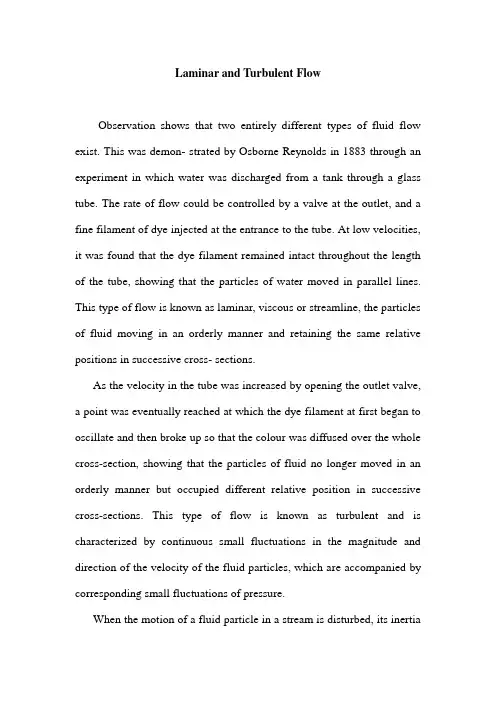
Laminar and Turbulent FlowObservation shows that two entirely different types of fluid flow exist. This was demon- strated by Osborne Reynolds in 1883 through an experiment in which water was discharged from a tank through a glass tube. The rate of flow could be controlled by a valve at the outlet, and a fine filament of dye injected at the entrance to the tube. At low velocities, it was found that the dye filament remained intact throughout the length of the tube, showing that the particles of water moved in parallel lines. This type of flow is known as laminar, viscous or streamline, the particles of fluid moving in an orderly manner and retaining the same relative positions in successive cross- sections.As the velocity in the tube was increased by opening the outlet valve, a point was eventually reached at which the dye filament at first began to oscillate and then broke up so that the colour was diffused over the whole cross-section, showing that the particles of fluid no longer moved in an orderly manner but occupied different relative position in successive cross-sections. This type of flow is known as turbulent and is characterized by continuous small fluctuations in the magnitude and direction of the velocity of the fluid particles, which are accompanied by corresponding small fluctuations of pressure.When the motion of a fluid particle in a stream is disturbed, its inertiawill tend to carry it on in the new direction, but the viscous forces due to the surrounding fluid will tend to make it conform to the motion of the rest of the stream. In viscous flow, the viscous shear stresses are sufficient to eliminate the effects of any deviation, but in turbulent flow they are inadequate. The criterion which determines whether flow will be viscous of turbulent is therefore the ratio of the inertial force to the viscous force acting on the particle. The ratioμρvl const force Viscous force Inertial ⨯= Thus, the criterion which determines whether flow is viscous or turbulent is the quantity ρvl /μ, known as the Reynolds number. It is a ratio of forces and, therefore, a pure number and may also be written as ul /v where is the kinematic viscosity (v=μ/ρ).Experiments carried out with a number of different fluids in straight pipes of different diameters have established that if the Reynolds number is calculated by making 1 equal to the pipe diameter and using the mean velocity v , then, below a critical value of ρvd /μ = 2000, flow will normally be laminar (viscous), any tendency to turbulence being damped out by viscous friction. This value of the Reynolds number applies only to flow in pipes, but critical values of the Reynolds number can be established for other types of flow, choosing a suitable characteristic length such as the chord of an aerofoil in place of the pipe diameter. For agiven fluid flowing in a pipe of a given diameter, there will be a critical velocity of flow corresponding to the critical value of the Reynolds number, below which flow will be viscous.In pipes, at values of the Reynolds number > 2000, flow will not necessarily be turbulent. Laminar flow has been maintained up to Re = 50,000, but conditions are unstable and any disturbance will cause reversion to normal turbulent flow. In straight pipes of constant diameter, flow can be assumed to be turbulent if the Reynolds number exceeds 4000.Pipe NetworksAn extension of compound pipes in parallel is a case frequently encountered in municipal distribution system, in which the pipes are interconnected so that the flow to a given outlet may come by several different paths. Indeed, it is frequently impossible to tell by inspection which way the flow travels. Nevertheless, the flow in any networks, however complicated, must satisfy the basic relations of continuity and energy as follows:1. The flow into any junction must equal the flow out of it.2. The flow in each pipe must satisfy the pipe-friction laws for flow in a single pipe.3. The algebraic sum of the head losses around any closed circuit must be zero.Pipe networks are generally too complicated to solve analytically, as was possible in the simpler cases of parallel pipes. A practical procedure is the method of successive approximations, introduced by Cross. It consists of the following elements, in order:1. By careful inspection assume the most reasonable distribution of flows that satisfies condition 1.2. Write condition 2 for each pipe in the formh L = KQ n(7.5) where K is a constant for each pipe. For example, the standard pipe-friction equation would yield K= 1/C2and n= 2 for constant f. Minor losses within any circuit may be included, but minor losses at the junction points are neglected.3. To investigate condition 3, compute the algebraic sum of the head losses around each elementary circuit. ∑h L= ∑KQ n. Consider losses from clockwise flows as positive, counterclockwise negative. Only by good luck will these add to zero on the first trial.4. Adjust the flow in each circuit by a correction, ΔQ , to balance the head in that circuit and give ∑KQ n = 0. The heart of this method lies in the determination of ΔQ . For any pipe we may writeQ = Q 0 +ΔQwhere Q is the correct discharge and Q 0 is the assumed discharge. Then, for a circuit100/Q h n h Q Kn Q K Q L L n n ∑∑∑∑∆-=-=- (7.6) It must be emphasized again that the numerator of Eq. (7.6) is to be summed algebraically, with due account of sign, while the denominator is summed arithmetically. The negative sign in Eq. (7.6) indicates that when there is an excess of head loss around a loop in the clockwise direction, the ΔQ must be subtracted from clockwise Q 0’s and added to counterclockwise ones. The reverse is true if there is a deficiency of head loss around a loop in the clockwise direction.5. After each circuit is given a first correction, the losses will still not balance because of the interaction of one circuit upon another (pipes which are common to two circuits receive two independent corrections, one for each circuit). The procedure is repeated, arriving at a second correction, and so on, until the corrections become negligible.Either form of Eq. (7.6) may be used to find ΔQ . As values of K appear in both numerator and denominator of the first form, values proportional to the actual K may be used to find the distribution. Thesecond form will be found most convenient for use with pipe-friction diagrams for water pipes.An attractive feature of the approximation method is that errors in computation have the same effect as errors in judgment and will eventually be corrected by the process.The pipe-networks problem lends itself well to solution by use of a digital computer. Programming takes time and care, but once set up, there is great flexibility and many man-hours of labor can be saved.The Future of Plastic Pipe at Higher PressuresParticipants in an AGA meeting panel on plastic pipe discussed the possibility of using polyethylene gas pipe at higher pressures. Topics included the design equation, including work being done by ISO on an updated version, and the evaluation of rapid crack propagation in a PE pipe resin. This is of critical importance because as pipe is used at higher pressure and in larger diameters, the possibility of RCP increases.Several years ago, AGA’s Plastic Pipe Design Equation Task Group reviewed the design equation to determine if higher operating pressurescould be used in plastic piping systems. Members felt the performance of our pipe resins was not truly reflected by the design equation. It was generally accepted that the long-term properties of modern resins far surpassed those of older resins. Major considerations were new equations being developed and selection of an appropriate design factor.Improved pipe performanceMany utilities monitored the performance of plastic pipe resins. Here are some of the long-term tests used and the kinds of performance change they have shown for typical gas pipe resins.Elevated temperature burst testThey used tests like the Elevated Temperature Burst Test, in which the long-term performance of the pipe is checked by measuring the time required for formation of brittle cracks in the pipe wall under high temperatures and pressures (often 80 degrees C and around 4 to 5-MPa hoop stress). At Consumers Gas we expected early resins to last at least 170 hrs. at 80 degrees C and a hoop stress of 3 MPa. Extrapolation showed that resins passing these limits should have a life expectancy of more than 50 yrs. Quality control testing on shipments of pipe made fromthese resins sometimes resulted in product rejection for failure to meet this criterion.At the same temperature, today’s resins last thousands of hours at hoop stresses of 4.6 MPa. Tests performed on pipe made from new resins have been terminated with no failure at times exceeding 5,700 hrs. These results were performed on samples that were squeezed off before testing. Such stresses were never applied in early testing. When extrapolated to operating conditions, this difference in test performance is equivalent to an increase in lifetime of hundreds (and in some cases even thousands) of years.Environmental stress crack resistance testSome companies also used the Environmental Stress Crack Resistance test which measured brittle crack formation in pipes but which used stress cracking agents to shorten test times.This test has also shown dramatic improvement in resistance brittle failure. For example, at my company a test time of more than 20 hrs. at 50 degrees C was required on our early resins. Today’s resins last well above 1,000 hrs. with no failure.Notch testsNotch tests, which are quickly run, measure brittle crack formation in notched pipe or molded coupon samples. This is important for the newer resins since some other tests to failure can take very long times. Notch test results show that while early resins lasted for test times ranging between 1,000 to 10,000 min., current resins usually last for longer than 200,000 min.All of our tests demonstrated the same thing. Newer resins are much more resistant to the growth of brittle crack than their predecessors. Since brittle failure is considered to be the ultimate failure mechanism in polyethylene pipes, we know that new materials will last much longer than the old. This is especially reassuring to the gas industry since many of these older resins have performed very well in the field for the past 25 yrs. with minimal detectable change in properties.While the tests showed greatly improved performance, the equation used to establish the pressure rating of the pipe is still identical to the original except for a change in 1978 to a single design factor for all class locations.To many it seemed that the methods used to pressure rate our pipe were now unduly conservative and that a new design equation was needed. At this time we became aware of a new equation being balloted atISO. The methodology being used seemed to be a more technically correct method of analyzing the data and offered a number of advantages.Thermal Expansion of Piping and Its CompensationA very relevant consideration requiring careful attention is the fact that with temperature of a length of pipe raised or lowered, there is a corresponding increase or decrease in its length and cross-sectional area because of the inherent coefficient of thermal expansion for the particular pipe material. The coefficient of expansion for carbon steel is 0.012 mm/m˚C and for copper 0.0168mm/m˚C. Respective module of elasticity are for steel E = 207×1.06kN/m2 and for copper E = 103×106 kN/m2. As an example, assuming a base temperature for water conducting piping at 0˚C, a steel pipe of any diameter if heated to 120˚C would experience a linear extension of 1.4 mm and a similarly if heated to copper pipe would extend by 2.016 mm for each meter of their respective lengths. The unit axial force in the steel pipe however would be 39% greater than for copper. The change in pipe diameter is of no practical consequence to linear extension but the axial forces created by expansion or contractionare con- siderable and capable of fracturing any fitments which may tend to impose a restraint;the magnitude of such forces is related to pipe size. As an example,in straight pipes of same length but different diameters, rigidly held at both ends and with temperature raised by say 100˚C, total magnitude of linear forces against fixed points would be near enough proportionate to the respective diameters.It is therefore essential that design of any piping layout makes adequate com- pensatory provision for such thermal influence by relieving the system of linear stresses which would be directly related to length of pipework between fixed points and the range of operational temperatures.Compensation for forces due to thermal expansion. The ideal pipework as far as expansion is concerned, is one where maximum free movement with the minimum of restraint is possible. Hence the simplest and most economical way to ensure com- pensation and relief of forces is to take advantage of changes in direction, or where this is not part of the layout and long straight runs are involved it may be feasible to introduce deliberate dog-leg offset changes in direction at suitable intervals.As an alternative,at calculated intervals in a straight pipe run specially designed expansion loops or “U” bends should be inserted. Depending upon design and space availability, expansion bends within a straight pipe run can feature the so called double offset “U” band or thehorseshoe type or “lyre” loop.The last named are seldom used for large heating networks; they can be supplied in manufacturers’ standard units but require elaborate constructional works for underground installation.Anchored thermal movement in underground piping would normally be absorbed by three basic types of expansion bends and these include the “U”bend, the “L”bend and the “Z”bend.In cases of 90 changes indirection the “L” and “Z”bends are used.Principles involved in the design of provision for expansion between anchor points are virtually the same for all three types of compensator. The offset “U” bend is usually made up from four 90° elbows and straight pipes; it permits good thermal displacement and imposes smaller anchor loads than the other type of loop. This shape of expansion bend is the standardised pattern for prefabricated pipe-in-pipe systems.All thermal compensators are installed to accommodate an equal amount of expansion or contraction; therefore to obtain full advantage of the length of thermal movement it is necessary to extend the unit during installation thus opening up the loop by an extent roughly equal the half the overall calculated thermal movement.This is done by “cold-pull” or other mechanical means. The total amount of extension between two fixed points has to be calculated on basis of ambient temperature prevailing and operational design temperatures so that distribution of stresses and reactions at lower and higher temperatures are controlledwithin permissible limits. Pre-stressing does not affect the fatigue life of piping therefore it does not feature in calculation of pipework stresses .There are numerous specialist publication dealing with design and stressing calculations for piping and especially for proprietary piping and expansion units; comprehensive experience back design data as well as charts and graphs may be obtained in manufacturers’publications, offering solutions for every kind of pipe stressing problem.As an alternative to above mentioned methods of compensation for thermal expansion and useable in places where space is restricted, is the more expensive bellows or telescopic type mechanical compensator. There are many proprietary types and models on the market and the following types of compensators are generally used.The bellows type expansion unit in form of an axial compensator provides for expansion movement in a pipe along its axis; motion in this bellows is due to tension or compression only.There are also articulated bellows units restrained which combine angular and lateral movement; they consist of double compensator units restrained by straps pinned over the center of each bellowsor double tied thus being restrained over its length.Such compensators are suitable for accommodating very pipeline expansion and also for combinations of angular and lateral movements.层流与紊流有两种完全不同的流体流动形式存在,这一点在1883年就由Osborne Reynolds 用试验演示证明。
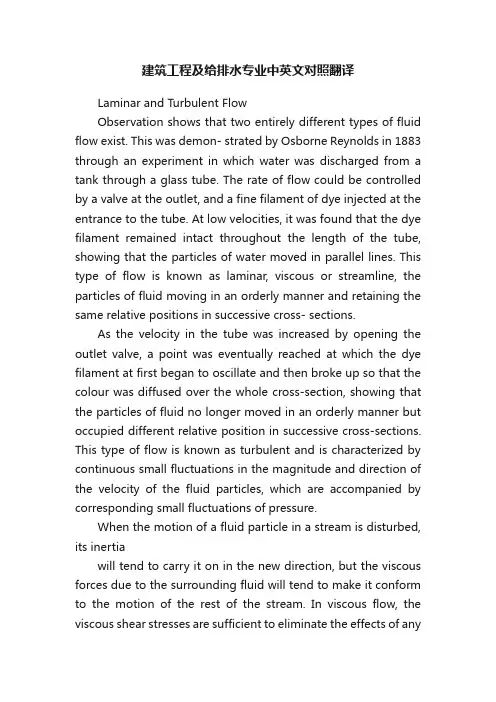
建筑工程及给排水专业中英文对照翻译Laminar and Turbulent FlowObservation shows that two entirely different types of fluid flow exist. This was demon- strated by Osborne Reynolds in 1883 through an experiment in which water was discharged from a tank through a glass tube. The rate of flow could be controlled by a valve at the outlet, and a fine filament of dye injected at the entrance to the tube. At low velocities, it was found that the dye filament remained intact throughout the length of the tube, showing that the particles of water moved in parallel lines. This type of flow is known as laminar, viscous or streamline, the particles of fluid moving in an orderly manner and retaining the same relative positions in successive cross- sections.As the velocity in the tube was increased by opening the outlet valve, a point was eventually reached at which the dye filament at first began to oscillate and then broke up so that the colour was diffused over the whole cross-section, showing that the particles of fluid no longer moved in an orderly manner but occupied different relative position in successive cross-sections. This type of flow is known as turbulent and is characterized by continuous small fluctuations in the magnitude and direction of the velocity of the fluid particles, which are accompanied by corresponding small fluctuations of pressure.When the motion of a fluid particle in a stream is disturbed, its inertiawill tend to carry it on in the new direction, but the viscous forces due to the surrounding fluid will tend to make it conform to the motion of the rest of the stream. In viscous flow, the viscous shear stresses are sufficient to eliminate the effects of anydeviation, but in turbulent flow they are inadequate. The criterion which determines whether flow will be viscous of turbulent is therefore the ratio of the inertial force to the viscous force acting on the particle. The ratioμρvl const force Viscous force Inertial ?= Thus, the criter ion which determines whether flow is viscous or turbulent is the quantity ρvl /μ, known as the Reynolds number. It is a ratio of forces and, therefore, a pure number and may also be written as ul /v where is the kinematic viscosity (v=μ/ρ).Experiments carried out with a number of different fluids in straight pipes of different diameters have established that if the Reynolds number is calculated by making 1 equal to the pipe diameter and using the mean velocity v , then, below a critical value of ρvd /μ = 2000, flow will normally be laminar (viscous), any tendency to turbulence being damped out by viscous friction. This value of the Reynolds number applies only to flow in pipes, but critical values of the Reynolds number can be established for other types of flow, choosing a suitable characteristic length such as the chord of an aerofoil in place of the pipe diameter. For a given fluid flowing in a pipe of a given diameter, there will be a critical velocity of flow corresponding to the critical value of the Reynolds number, below which flow will be viscous.In pipes, at values of the Reynolds number > 2000, flow will not necessarily be turbulent. Laminar flow has been maintained up to Re = 50,000, but conditions are unstable and any disturbance will cause reversion to normal turbulent flow. In straight pipes of constant diameter, flow can be assumed to be turbulent if the Reynolds number exceeds 4000.Pipe NetworksAn extension of compound pipes in parallel is a case frequently encountered in municipal distribution system, in which the pipes are interconnected so that the flow to a given outlet may come by several different paths. Indeed, it is frequently impossible to tell by inspection which way the flow travels. Nevertheless, the flow in any networks, however complicated, must satisfy the basic relations of continuity and energy as follows:1. The flow into any junction must equal the flow out of it.2. The flow in each pipe must satisfy the pipe-friction laws for flow in a single pipe.3. The algebraic sum of the head losses around any closed circuit must be zero.Pipe networks are generally too complicated to solve analytically, as was possible in the simpler cases of parallel pipes.A practical procedure is the method of successive approximations, introduced by Cross. It consists of the following elements, in order:1. By careful inspection assume the most reasonable distribution of flows that satisfies condition 1.2. Write condition 2 for each pipe in the formh L = KQ n(7.5) where K is a constant for each pipe. For example, the standard pipe-friction equation would yield K= 1/C2and n= 2 for constant f. Minor losses within any circuit may be included, but minor losses at the junction points are neglected.3. To investigate condition 3, compute the algebraic sum of the head losses around each elementary circuit. ∑h L= ∑KQ n. Consider losses from clockwise flows as positive, counterclockwise negative. Only by good luck will these add tozero on the first trial.4. Adjust the flow in each circuit by a correction, ΔQ , to balance the head in that circuit and give ∑KQ n = 0. The heart of this method lies in the determination of ΔQ . For any pipe we may writeQ = Q 0 +ΔQwhere Q is the correct discharge and Q 0 is the assumed discharge. Then, for a circuit100/Q h n h Q Kn Q K Q L L n n ∑∑∑∑?-=-=- (7.6) It must be emphasized again that the numerator of Eq. (7.6) is to be summed algebraically, with due account of sign, while the denominator is summed arithmetically. The negative sign in Eq.(7.6) indicates that when there is an excess of head loss around a loop in the clockwise direction, the ΔQ must be subtracted from clockwise Q 0’s and added to counterclockwise ones. The reverse is true if there is a deficiency of head loss around a loop in the clockwise direction.5. After each circuit is given a first correction, the losses will still not balance because of the interaction of one circuit upon another (pipes which are common to two circuits receive two independent corrections, one for each circuit). The procedure is repeated, arriving at a second correction, and so on, until the corrections become negligible.Either form of Eq. (7.6) may be used to find ΔQ . As values of K appear in both numerator and denominator of the first form, values proportional to the actual K may be used to find the distribution. Thesecond form will be found most convenient for use with pipe-friction diagrams for water pipes.An attractive feature of the approximation method is thaterrors in computation have the same effect as errors in judgment and will eventually be corrected by the process.The pipe-networks problem lends itself well to solution by use of a digital computer. Programming takes time and care, but once set up, there is great flexibility and many man-hours of labor can be saved.The Future of Plastic Pipe at Higher PressuresParticipants in an AGA meeting panel on plastic pipe discussed the possibility of using polyethylene gas pipe at higher pressures. Topics included the design equation, including work being done by ISO on an updated version, and the evaluation of rapid crack propagation in a PE pipe resin. This is of critical importance because as pipe is used at higher pressure and in larger diameters, the possibility of RCP increases.Se veral years ago, AGA’s Plastic Pipe Design Equation Task Group reviewed the design equation to determine if higher operating pressurescould be used in plastic piping systems. Members felt the performance of our pipe resins was not truly reflected by the design equation. It was generally accepted that the long-term properties of modern resins far surpassed those of older resins. Major considerations were new equations being developed and selection of an appropriate design factor.Improved pipe performanceMany utilities monitored the performance of plastic pipe resins. Here are some of the long-term tests used and the kinds of performance change they have shown for typical gas pipe resins.Elevated temperature burst testThey used tests like the Elevated Temperature Burst T est, inwhich the long-term performance of the pipe is checked by measuring the time required for formation of brittle cracks in the pipe wall under high temperatures and pressures (often 80 degrees C and around 4 to 5-MPa hoop stress). At Consumers Gas we expected early resins to last at least 170 hrs. at 80 degrees C and a hoop stress of 3 MPa. Extrapolation showed that resins passing these limits should have a life expectancy of more than 50 yrs. Quality control testing on shipments of pipe made fromthese resins sometimes resulted in product rejection for failure to meet this criterion.At the same temperature, today’s resins last thousands of hours at hoop stresses of 4.6 MPa. Tests performed on pipe made from new resins have been terminated with no failure at times exceeding 5,700 hrs. These results were performed on samples that were squeezed off before testing. Such stresses were never applied in early testing. When extrapolated to operating conditions, this difference in test performance is equivalent to an increase in lifetime of hundreds (and in some cases even thousands) of years.Environmental stress crack resistance testSome companies also used the Environmental Stress Crack Resistance test which measured brittle crack formation in pipes but which used stress cracking agents to shorten test times.This test has also shown dramatic improvement in resistance brittle failure. For example, at my company a test time of more than 20 hrs. at 50 degrees C was required on our early resins. Today’s resins last well above 1,000 hrs. with no failure.Notch testsNotch tests, which are quickly run, measure brittle crack formation in notched pipe or molded coupon samples. This isimportant for the newer resins since some other tests to failure can take very long times. Notch test results show that while early resins lasted for test times ranging between 1,000 to 10,000 min., current resins usually last for longer than 200,000 min.All of our tests demonstrated the same thing. Newer resins are much more resistant to the growth of brittle crack than their predecessors. Since brittle failure is considered to be the ultimate failure mechanism in polyethylene pipes, we know that new materials will last much longer than the old. This is especially reassuring to the gas industry since many of these older resins have performed very well in the field for the past 25 yrs. with minimal detectable change in properties.While the tests showed greatly improved performance, the equation used to establish the pressure rating of the pipe is still identical to the original except for a change in 1978 to a single design factor for all class locations.To many it seemed that the methods used to pressure rate our pipe were now unduly conservative and that a new design equation was needed. At this time we became aware of a new equation being balloted atISO. The methodology being used seemed to be a more technically correct method of analyzing the data and offered a number of advantages.Thermal Expansion of Piping and Its CompensationA very relevant consideration requiring careful attention is the fact that with temperature of a length of pipe raised or lowered, there is a corresponding increase or decrease in its length and cross-sectional area because of the inherent coefficient of thermal expansion for the particular pipe material. The coefficient of expansion for carbon steel is 0.012 mm/m?Cand for copper 0.0168mm/m?C. Respective module of elasticity a re for steel E = 207×1.06kN/m2 and for copper E = 103×106 kN/m2. As an example, assuming a base temperature for water conducting piping at 0?C, a steel pipe of any diameter if heated to 120?C would experience a linear extension of 1.4 mm and a similarly if heated to copper pipe would extend by 2.016 mm for each meter of their respective lengths. The unit axial force in the steel pipe however would be 39% greater than for copper. The change in pipe diameter is of no practical consequence to linear extension but the axial forces created by expansion or contractionare con- siderable and capable of fracturing any fitments which may tend to impose a restraint;the magnitude of such forces is related to pipe size. As an example,in straight pipes of same length but different diameters, rigidly held at both ends and with temperature raised by say 100?C, total magnitude of linear forces against fixed points would be near enough proportionate to the respective diameters.It is therefore essential that design of any piping layout makes adequate com- pensatory provision for such thermal influence by relieving the system of linear stresses which would be directly related to length of pipework between fixed points and the range of operational temperatures.Compensation for forces due to thermal expansion. The ideal pipework as far as expansion is concerned, is one where maximum free movement with the minimum of restraint is possible. Hence the simplest and most economical way to ensure com- pensation and relief of forces is to take advantage of changes in direction, or where this is not part of the layout and long straight runs are involved it may be feasible to introducedeliberate dog-leg offset changes in direction at suitable intervals.As an alternative,at calculated intervals in a straight pipe run specially designed expansion loops or “U” bends should be inserted. Depending upon design and space availability, expansion bends within a straight pipe run can feature the so called double offset “U” band or thehorseshoe typ e or “lyre” loop.The last named are seldom used for large heating networks; they can be supplied in manufacturers’ standard units but require elaborate constructional works for underground installation.Anchored thermal movement in underground piping would normally be absorbed by three basic types of expansion bends and these include the “U”bend, the “L”bend and the “Z”bend.In cases of 90 changes indirection the “L” and “Z”bends are used.Principles involved in the design of provision for expansion between anchor points are virtually the same for all three types of compensator. The offset “U” bend is usually made up from four 90° elbows and straight pipes; it permits good thermal displacement and imposes smaller anchor loads than the other type of loop. This shape of expansion bend is the standardised pattern for prefabricated pipe-in-pipe systems.All thermal compensators are installed to accommodate an equal amount of expansion or contraction; therefore to obtain full advantage of the length of thermal movement it is necessary to extend the unit during installation thus opening up the loop by an extent roughly equal the half the overall calculated thermal movement.This is done by “cold-pull” or other mechanical means. The total amount of extension between two fixed pointshas to be calculated on basis of ambient temperature prevailing and operational design temperatures so that distribution of stresses and reactions at lower and higher temperatures are controlledwithin permissible limits. Pre-stressing does not affect the fatigue life of piping therefore it does not feature in calculation of pipework stresses .There are numerous specialist publication dealing with design and stressing calculations for piping and especially for proprietary piping and expansion units; comprehensive experience back design data as well as charts and graphs may be obtained in manufacturers’publications, offering solutions for every kind of pipe stressing problem.As an alternative to above mentioned methods of compensation for thermal expansion and useable in places where space is restricted, is the more expensive bellows or telescopic type mechanical compensator. There are many proprietary types and models on the market and the following types of compensators are generally used.The bellows type expansion unit in form of an axial compensator provides for expansion movement in a pipe along its axis; motion in this bellows is due to tension or compression only.There are also articulated bellows units restrained which combine angular and lateral movement; they consist of double compensator units restrained by straps pinned over the center of each bellowsor double tied thus being restrained over its length.Such compensators are suitable for accommodating very pipeline expansion and also for combinations of angular and lateral movements.层流与紊流有两种完全不同的流体流动形式存在,这一点在1883年就由Osborne Reynolds 用试验演示证明。
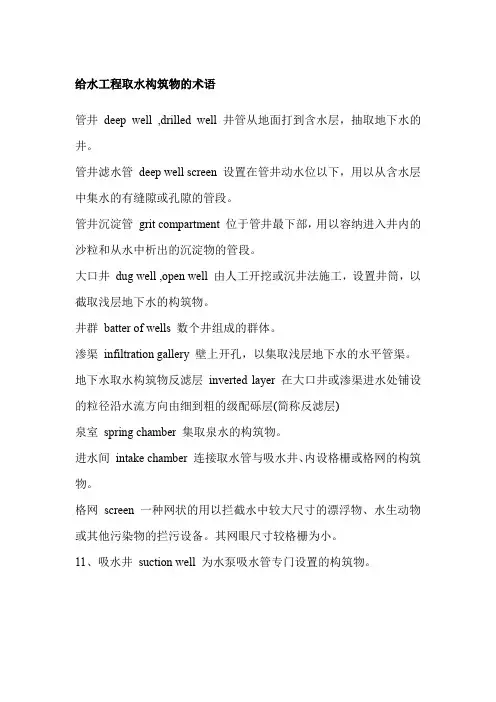
给水工程取水构筑物的术语管井deep well ,drilled well 井管从地面打到含水层,抽取地下水的井。
管井滤水管deep well screen 设置在管井动水位以下,用以从含水层中集水的有缝隙或孔隙的管段。
管井沉淀管grit compartment 位于管井最下部,用以容纳进入井内的沙粒和从水中析出的沉淀物的管段。
大口井dug well ,open well 由人工开挖或沉井法施工,设置井筒,以截取浅层地下水的构筑物。
井群batter of wells 数个井组成的群体。
渗渠infiltration gallery 壁上开孔,以集取浅层地下水的水平管渠。
地下水取水构筑物反滤层inverted layer 在大口井或渗渠进水处铺设的粒径沿水流方向由细到粗的级配砾层(简称反滤层)泉室spring chamber 集取泉水的构筑物。
进水间intake chamber 连接取水管与吸水井、内设格栅或格网的构筑物。
格网screen 一种网状的用以拦截水中较大尺寸的漂浮物、水生动物或其他污染物的拦污设备。
其网眼尺寸较格栅为小。
11、吸水井suction well 为水泵吸水管专门设置的构筑物。
排水工程中物理量的术语及其涵义生化需氧量biochmical oxygen demand 水样在一定条件下,于一定期间内(一般采用5日、20℃)进行需氧化所消耗的溶解氧量。
英文简称BOD。
化学需氧量chemical oxygen demand 水样中可氧化物从氧化剂重铬酸钾中所吸收的氧量。
英文简称COD。
耗氧量oxygen consumption 水样中氧化物从氧化剂高锰酸钾所吸收的氧量。
英文简称OC或CODMn 。
悬浮固体suspended solid 水中呈悬浮状态的固体,一般指用滤纸过滤水样,将滤后截留物在105℃温度中干燥恒重后的固体重量。
英文简称SS常用名词中英文对照给水工程water supply engineering 原水的取集和处理以及成品水输配的工程。
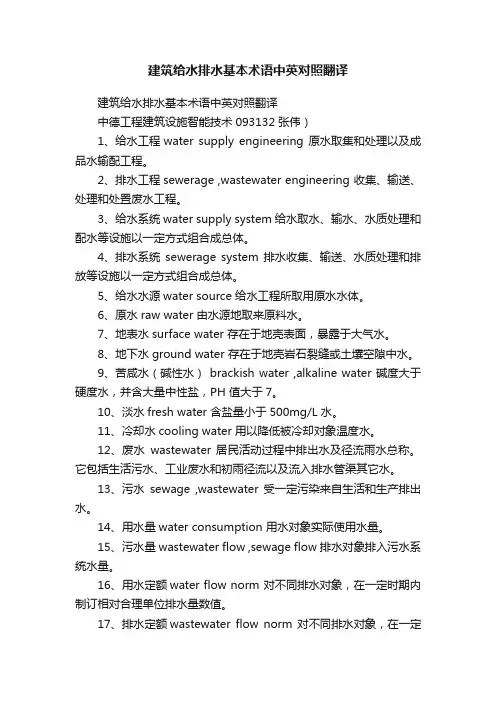
建筑给水排水基本术语中英对照翻译建筑给水排水基本术语中英对照翻译中德工程建筑设施智能技术093132 张伟)1、给水工程water supply engineering 原水取集和处理以及成品水输配工程。
2、排水工程sewerage ,wastewater engineering 收集、输送、处理和处置废水工程。
3、给水系统water supply system 给水取水、输水、水质处理和配水等设施以一定方式组合成总体。
4、排水系统sewerage system 排水收集、输送、水质处理和排放等设施以一定方式组合成总体。
5、给水水源water source 给水工程所取用原水水体。
6、原水raw water 由水源地取来原料水。
7、地表水surface water 存在于地壳表面,暴露于大气水。
8、地下水ground water 存在于地壳岩石裂缝或土壤空隙中水。
9、苦咸水(碱性水) brackish water ,alkaline water 碱度大于硬度水,并含大量中性盐,PH 值大于7。
10、淡水fresh water 含盐量小于500mg/L 水。
11、冷却水cooling water 用以降低被冷却对象温度水。
12、废水wastewater 居民活动过程中排出水及径流雨水总称。
它包括生活污水、工业废水和初雨径流以及流入排水管渠其它水。
13、污水sewage ,wastewater 受一定污染来自生活和生产排出水。
14、用水量water consumption 用水对象实际使用水量。
15、污水量wastewater flow ,sewage flow 排水对象排入污水系统水量。
16、用水定额water flow norm 对不同排水对象,在一定时期内制订相对合理单位排水量数值。
17、排水定额wastewater flow norm 对不同排水对象,在一定时期内制订相对合理单位排水量数值。
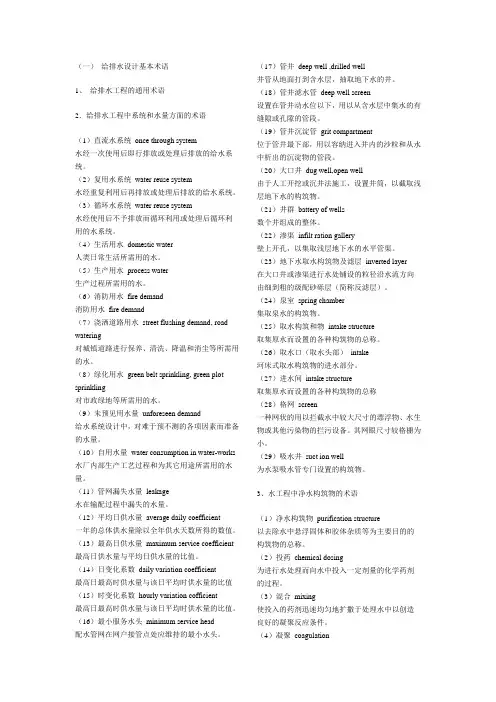
(一)给排水设计基本术语1、给排水工程的通用术语2.给排水工程中系统和水量方面的术语(1)直流水系统once through system水经一次使用后即行排放或处理后排放的给水系统。
(2)复用水系统water reuse system水经重复利用后再排放或处理后排放的给水系统。
(3)循环水系统water reuse system水经使用后不予排放而循环利用或处理后循环利用的水系统。
(4)生活用水domestic water人类日常生活所需用的水。
(5)生产用水process water生产过程所需用的水。
(6)消防用水fire demand消防用水fire demand(7)浇洒道路用水street flushing demand, road watering对城镇道路进行保养、清洗、降温和消尘等所需用的水。
(8)绿化用水green belt sprinkling, green plot sprinkling对市政绿地等所需用的水。
(9)未预见用水量unforeseen demand给水系统设计中,对难于预不测的各项因素而准备的水量。
(10)自用水量water consumption in water-works 水厂内部生产工艺过程和为其它用途所需用的水量。
(11)管网漏失水量leakage水在输配过程中漏失的水量。
(12)平均日供水量average daily coefficient一年的总体供水量除以全年供水天数所得的数值。
(13)最高日供水量maximum service coefficient 最高日供水量与平均日供水量的比值。
(14)日变化系数daily variation coefficient最高日最高时供水量与该日平均时供水量的比值(15)时变化系数hourly variation cofficient最高日最高时供水量与该日平均时供水量的比值。
(16)最小服务水头minimum service head配水管网在网户接管点处应维持的最小水头。
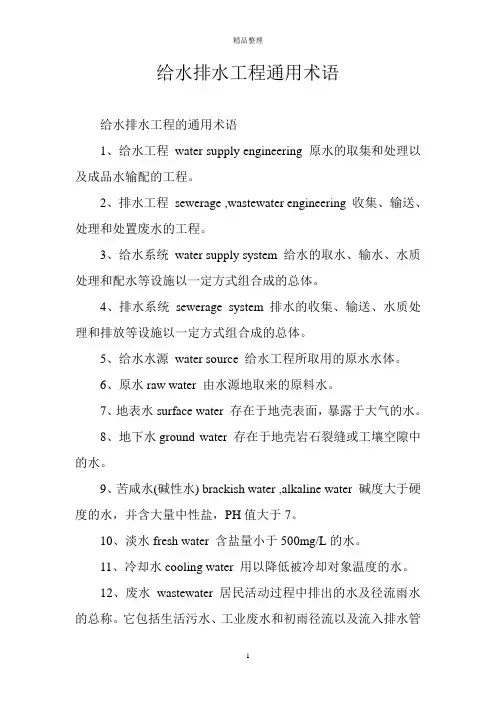
给水排水工程通用术语给水排水工程的通用术语1、给水工程water supply engineering 原水的取集和处理以及成品水输配的工程。
2、排水工程sewerage ,wastewater engineering 收集、输送、处理和处置废水的工程。
3、给水系统water supply system 给水的取水、输水、水质处理和配水等设施以一定方式组合成的总体。
4、排水系统sewerage system 排水的收集、输送、水质处理和排放等设施以一定方式组合成的总体。
5、给水水源water source 给水工程所取用的原水水体。
6、原水raw water 由水源地取来的原料水。
7、地表水surface water 存在于地壳表面,暴露于大气的水。
8、地下水ground water 存在于地壳岩石裂缝或工壤空隙中的水。
9、苦咸水(碱性水) brackish water ,alkaline water 碱度大于硬度的水,并含大量中性盐,PH值大于7。
10、淡水fresh water 含盐量小于500mg/L的水。
11、冷却水cooling water 用以降低被冷却对象温度的水。
12、废水wastewater 居民活动过程中排出的水及径流雨水的总称。
它包括生活污水、工业废水和初雨径流以及流入排水管渠的其它水。
13、污水sewage ,wastewater 受一定污染的来自生活和生产的排出水。
14、用水量water consumption 用水对象实际使用的水量。
15、污水量wastewater flow ,sewage flow 排水对象排入污水系统的水量。
16、用水定额water flow norm 对不同的排水对象,在一定时期内制订相对合理的单位排水量的数值。
17、排水定额wastewater flow norm 对不同的排水对象,在一定时期内制订相对合理的单位排水量的数值。
18、水质water quality 在给水排水工程中,水的物理、化学、生物学等方面的性质。
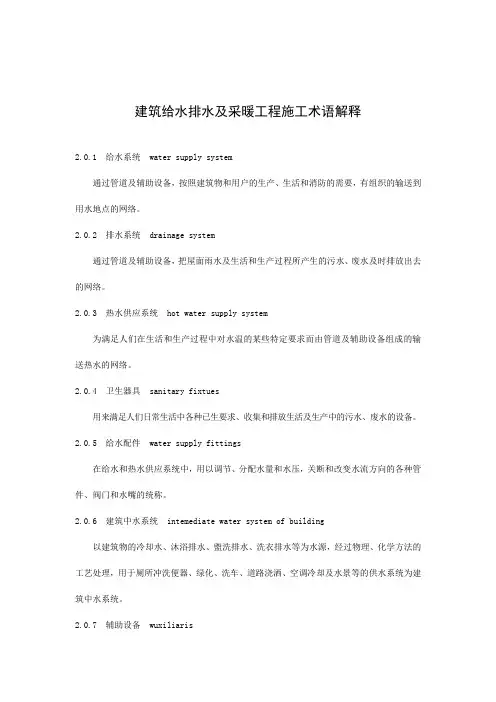
建筑给水排水及采暖工程施工术语解释2.0.1 给水系统 water supply system通过管道及辅助设备,按照建筑物和用户的生产、生活和消防的需要,有组织的输送到用水地点的网络。
2.0.2 排水系统 drainage system通过管道及辅助设备,把屋面雨水及生活和生产过程所产生的污水、废水及时排放出去的网络。
2.0.3 热水供应系统 hot water supply system为满足人们在生活和生产过程中对水温的某些特定要求而由管道及辅助设备组成的输送热水的网络。
2.0.4 卫生器具 sanitary fixtues用来满足人们日常生活中各种已生要求、收集和排放生活及生产中的污水、废水的设备。
2.0.5 给水配件 water supply fittings在给水和热水供应系统中,用以调节、分配水量和水压,关断和改变水流方向的各种管件、阀门和水嘴的统称。
2.0.6 建筑中水系统 intemediate water system of building以建筑物的冷却水、沐浴排水、盥洗排水、洗衣排水等为水源,经过物理、化学方法的工艺处理,用于厕所冲洗便器、绿化、洗车、道路浇洒、空调冷却及水景等的供水系统为建筑中水系统。
2.0.7 辅助设备 wuxiliaris建筑给水、排水及采暖系统中,为满足用户的各种使用功能和提高运行质量而设置的各种设备。
2.0.8 试验压力 text presssure管道、容器或设备进行耐压强度和气密性试验规定所要达到的压力。
2.0.9 额定工作压力 rated pressure指锅炉及压力容器出厂时所标定的最高允许工作压力。
2.0.10 管道配件 pipe fittings管道与管道或管道与设备连接用的各种零、配件的统称。
2.0.11 固定支架 fixed trestle限制管道在支撑点处发生轴向位移的管道支架。
2.0.12 活动支架 movable trestle允许管道在支撑点处发生轴向位移的管道支架。
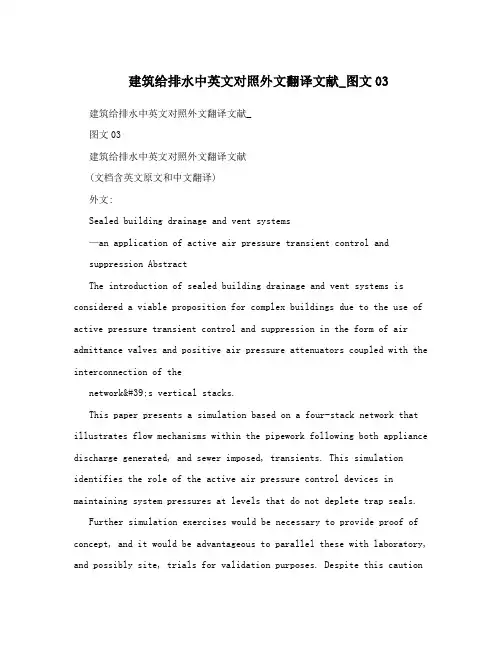
建筑给排水中英文对照外文翻译文献_图文03 建筑给排水中英文对照外文翻译文献_图文03建筑给排水中英文对照外文翻译文献(文档含英文原文和中文翻译)外文:Sealed building drainage and vent systems—an application of active air pressure transient control andsuppression AbstractThe introduction of sealed building drainage and vent systems is considered a viable proposition for complex buildings due to the use of active pressure transient control and suppression in the form of air admittance valves and positive air pressure attenuators coupled with the interconnection of thenetwork's vertical stacks.This paper presents a simulation based on a four-stack network that illustrates flow mechanisms within the pipework following both appliance discharge generated, and sewer imposed, transients. This simulation identifies the role of the active air pressure control devices in maintaining system pressures at levels that do not deplete trap seals.Further simulation exercises would be necessary to provide proof of concept, and it would be advantageous to parallel these with laboratory, and possibly site, trials for validation purposes. Despite this cautionthe initial results are highly encouraging and are sufficient to confirm the potential to provide definite benefits in terms of enhanced system security as well as increased reliability and reduced installation and material costs.Keywords: Active control; Trap retention; Transient propagationNomenclatureC+-——characteristic equationsc——wave speed, m/sD——branch or stack diameter, mf——friction factor, UK definition via Darcy Δh=4fLu2/2Dgg——acceleration due to gravity, m/s2K——loss coefficientL——pipe length, mp——air pressure, N/m2t——time, su——mean air velocity, m/sx——distance, mγ——ratio specific heatsΔh——head loss, mΔp——pressure difference, N/m2Δt——time step, sΔx——internodal length, mρ——density, kg/m3Article OutlineNomenclature1. Introduction—air pressure transient control and suppression2. Mathematical basis for the simulation of transient propagation in multi-stack building drainage networks3. Role of diversity in system operation4. Simulation of the operation of a multi-stack sealed building drainage and vent system5. Simulation sign conventions6. Water discharge to the network7. Surcharge at base of stack 18. Sewer imposed transients9. Trap seal oscillation and retention10. Conclusion—viability of a sealed building drainage and ventsystem1.Air pressure transients generated within building drainage andvent systems as a natural consequence of system operation may be responsible for trap seal depletion and cross contamination of habitable space [1]. Traditional modes of trap seal protection, based on the Victorian engineer's obsession with odour exclusion [2], [3] and [4], depend predominantly on passive solutions where reliance is placed on cross connections and vertical stacks vented toatmosphere [5] and [6]. This approach, while both proven and traditional, has inherent weaknesses, including the remoteness of the vent terminations [7], leading to delays in the arrival of relievingreflections, and the multiplicity of open roof level stack terminations inherent within complex buildings. The complexity of the vent system required also has significant cost and space implications [8].The development of air admittance valves (AAVs) over the past two decades provides the designer with a means of alleviating negative transients generated as random appliance dischargescontribute to the time dependent water-flow conditions within the system. AAVs represent an active control solution as they respond directly to the local pressure conditions, opening as pressure falls to allow a relief air inflow and hence limit the pressure excursions experienced by the appliance trap seal [9].However, AAVs do not address the problems of positive air pressure transient propagation within building drainage and vent systems as a result of intermittent closure of the free airpath through the network or the arrival of positive transients generated remotely within the sewer system, possibly by some surcharge event downstream—including heavy rainfall incombined sewer applications.The development of variable volume containment attenuators [10] that are designed to absorb airflow driven by positive air pressure transients completes the necessary device provision to allow active air pressure transient control and suppression to be introduced into the design of building drainage and vent systems, for both ‘standard’ buildings and those requiring particularattention to be paid to the security implications of multiple roof level open stack terminations. The positive air pressure attenuator (PAPA) consists of a variable volume bag that expands under theinfluence of a positive transient and therefore allows system airflowsto attenuate gradually, therefore reducing the level of positive transients generated. Together with the use of AAVs the introduction of the PAPA device allowsconsideration of a fully sealed building drainage and vent system. illustrates both AAV and PAPA devices, note that the waterless sheath trap acts as an AAFig. 1. Active air pressure transient suppression devices to control both positive and negative surges. Active air pressure transient suppressionand control therefore allows for localized intervention to protect trap seals from both positive and negative pressure excursions. This has distinct advantages over the traditional passive approach. The time delay inherent in awaiting the return of a relievingreflection from a vent open to atmosphere is removed and the effectof the transient on all the other system traps passed during its propagation is avoided.2.Mathematical basis for the simulation of transient propagation in multi-stack building drainage networks.The propagation of air pressure transients within building drainage and vent systems belongs to a well understood family of unsteady flowconditions defined by the St Venant equations of continuity and momentum, and solvable via a finite difference scheme utilizing the method of characteristics technique. Air pressure transient generation and propagation within the system as a result of air entrainment by thefalling annular water in the system vertical stacks and the reflection and transmission of these transients at the system boundaries, including open terminations, connections to the sewer, appliance trap seals and both AAV and PAPA active control devices, may be simulated with proven accuracy. The simulation [11] provides local air pressure, velocity and wave speed information throughout a network at time and distanceintervals as short as 0.001 s and 300 mm. In addition, the simulation replicates localappliance trap seal oscillations and the operation of active control devices, thereby yielding data on network airflows and identifying system failures and consequences. While the simulation has been extensively validated [10], its use to independently confirm the mechanism of SARS virus spread within the Amoy Gardens outbreak in 2003 has provided further confidence in its predictions [12].Air pressure transient propagation depends upon the rate of changeof the system conditions. Increasing annular downflow generates an enhanced entrained airflow and lowers the system pressure. Retarding the entrained airflow generates positive transients. External events mayalso propagate both positive and negative transients into the network.The annular water flow in the ‘wet’ stack entrains an airflowdue to the condition of ‘no slip’ established between theannular water and air core surfaces and generates the expected pressure variation down a vertical stack. Pressure falls from atmospheric above the stack entry due to friction and the effects of drawing air through the water curtains formed at discharging branch junctions. In the lower wet stack the pressure recovers to above atmospheric due to the traction forces exerted on the airflow prior to falling across the water curtain at the stack base.The application of the method of characteristics to the modelling of unsteady flows was first recognized in the 1960s [13]. The relationships defined by Jack [14] allows the simulation to model the traction force exerted on the entrained air. Extensive experimental data allowed the definition of a ‘pseudo-frictionfactor’ applicable in the wet stack and operable acro ss the water annular flow/entrained air core interface to allow combined discharge flows and their effect on air。
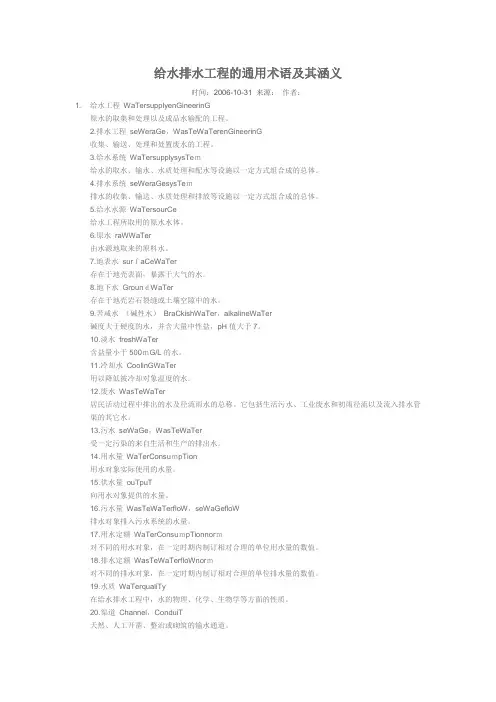
给水排水工程的通用术语及其涵义时间:2006-10-31 来源:作者:1. 给水工程WaTersupplyenGineerinG原水的取集和处理以及成品水输配的工程。
2.排水工程seWeraGe,WasTeWaTerenGineerinG收集、输送、处理和处置废水的工程。
3.给水系统WaTersupplysysTem给水的取水、输水、水质处理和配水等设施以一定方式组合成的总体。
4.排水系统seWeraGesysTem排水的收集、输送、水质处理和排放等设施以一定方式组合成的总体。
5.给水水源WaTersourCe给水工程所取用的原水水体。
6.原水raWWaTer由水源地取来的原料水。
7.地表水surfaCeWaTer存在于地壳表面,暴露于大气的水。
8.地下水GroundWaTer存在于地壳岩石裂缝或土壤空隙中的水。
9.苦咸水(碱性水)BraCkishWaTer,alkalineWaTer碱度大于硬度的水,并含大量中性盐,pH值大于7。
10.淡水freshWaTer含盐量小于500mG/L的水。
11.冷却水CoolinGWaTer用以降低被冷却对象温度的水。
12.废水WasTeWaTer居民活动过程中排出的水及径流雨水的总称。
它包括生活污水、工业废水和初雨径流以及流入排水管渠的其它水。
13.污水seWaGe,WasTeWaTer受一定污染的来自生活和生产的排出水。
14.用水量WaTerConsumpTion用水对象实际使用的水量。
15.供水量ouTpuT向用水对象提供的水量。
16.污水量WasTeWaTerfloW,seWaGefloW排水对象排入污水系统的水量。
17.用水定额WaTerConsumpTionnorm对不同的用水对象,在一定时期内制订相对合理的单位用水量的数值。
18.排水定额WasTeWaTerfloWnorm对不同的排水对象,在一定时期内制订相对合理的单位排水量的数值。
19.水质WaTerqualiTy在给水排水工程中,水的物理、化学、生物学等方面的性质。
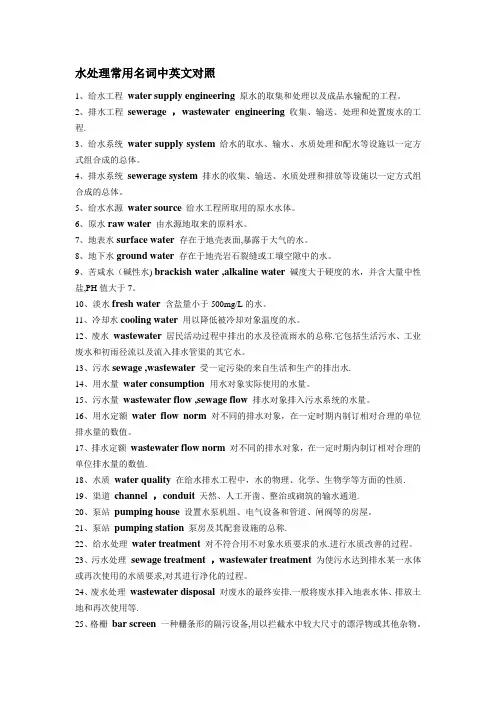
水处理常用名词中英文对照1、给水工程water supply engineering原水的取集和处理以及成品水输配的工程。
2、排水工程sewerage ,wastewater engineering收集、输送、处理和处置废水的工程.3、给水系统water supply system给水的取水、输水、水质处理和配水等设施以一定方式组合成的总体。
4、排水系统sewerage system排水的收集、输送、水质处理和排放等设施以一定方式组合成的总体。
5、给水水源water source给水工程所取用的原水水体。
6、原水raw water由水源地取来的原料水。
7、地表水surface water 存在于地壳表面,暴露于大气的水。
8、地下水ground water存在于地壳岩石裂缝或工壤空隙中的水。
9、苦咸水(碱性水) brackish water ,alkaline water碱度大于硬度的水,并含大量中性盐,PH值大于7。
10、淡水fresh water含盐量小于500mg/L的水。
11、冷却水cooling water用以降低被冷却对象温度的水。
12、废水wastewater居民活动过程中排出的水及径流雨水的总称.它包括生活污水、工业废水和初雨径流以及流入排水管渠的其它水。
13、污水sewage ,wastewater受一定污染的来自生活和生产的排出水.14、用水量water consumption 用水对象实际使用的水量。
-15、污水量wastewater flow ,sewage flow排水对象排入污水系统的水量。
16、用水定额water flow norm对不同的排水对象,在一定时期内制订相对合理的单位排水量的数值。
17、排水定额wastewater flow norm对不同的排水对象,在一定时期内制订相对合理的单位排水量的数值.18、水质water quality在给水排水工程中,水的物理、化学、生物学等方面的性质.19、渠道channel ,conduit天然、人工开凿、整治或砌筑的输水通道.20、泵站pumping house设置水泵机组、电气设备和管道、闸阀等的房屋。
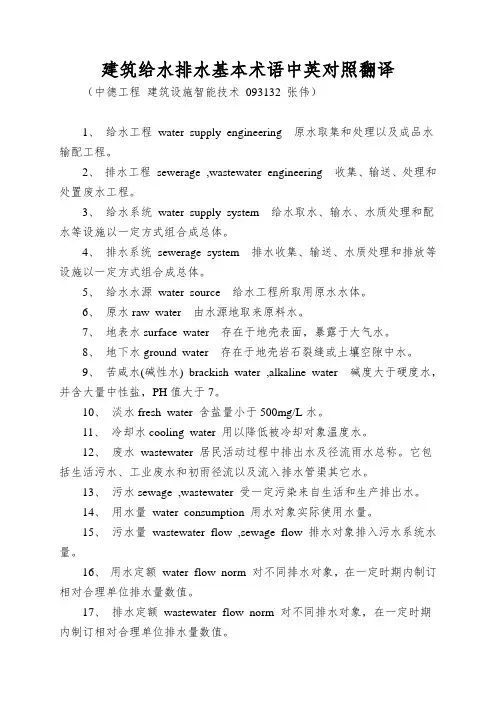
建筑给水排水基本术语中英对照翻译(中德工程建筑设施智能技术093132 张伟)1、给水工程water supply engineering 原水取集和处理以及成品水输配工程。
2、排水工程sewerage ,wastewater engineering 收集、输送、处理和处置废水工程。
3、给水系统water supply system 给水取水、输水、水质处理和配水等设施以一定方式组合成总体。
4、排水系统sewerage system 排水收集、输送、水质处理和排放等设施以一定方式组合成总体。
5、给水水源water source 给水工程所取用原水水体。
6、原水raw water 由水源地取来原料水。
7、地表水surface water 存在于地壳表面,暴露于大气水。
8、地下水ground water 存在于地壳岩石裂缝或土壤空隙中水。
9、苦咸水(碱性水) brackish water ,alkaline water 碱度大于硬度水,并含大量中性盐,PH值大于7。
10、淡水fresh water 含盐量小于500mg/L水。
11、冷却水cooling water 用以降低被冷却对象温度水。
12、废水wastewater 居民活动过程中排出水及径流雨水总称。
它包括生活污水、工业废水和初雨径流以及流入排水管渠其它水。
13、污水sewage ,wastewater 受一定污染来自生活和生产排出水。
14、用水量water consumption 用水对象实际使用水量。
15、污水量wastewater flow ,sewage flow 排水对象排入污水系统水量。
16、用水定额water flow norm 对不同排水对象,在一定时期内制订相对合理单位排水量数值。
17、排水定额wastewater flow norm 对不同排水对象,在一定时期内制订相对合理单位排水量数值。
18、水质water quality 在给水排水工程中,水物理、化学、生物学等方面性质。
建筑给水排水基本术语中英对照翻译Building Water Supply and Drainage Terms Translation建筑给水排水基本术语中英对照翻译IntroductionBuilding water supply and drainage is an essential part of the construction process. Understanding the terminology involved is critical to ensure proper installation and safety. This article will provide a English to Chinese translation of some basic building water supply and drainage terminology for those involved in the construction industry or those looking to improve their language skills.术语Terminology1. Main Water Line: 主供水管2. Supply Line: 供水管道3. Drain Line: 排水管道4. Sewer Line: 污水管道5. Valve: 阀门6. Shut-off Valve: 切断阀门7. Pressure Regulator: 压力调节阀8. Pressure Relief Valve: 减压阀9. Backflow Preventer: 防回流阀10. Floor Drain: 地漏11. Trap: 管道弯头12. Trap Seal: 弯头水封13. Vent: 排气管14. Cleanout: 清洁口15. Water Meter: 水表16. Water Softener: 软水器17. Water Heater: 热水器18. Waste Water: 废水19. Grey Water: 灰水20. Black Water: 黑水Translation and Explanation1. Main Water Line: The main water line refers to the water supply line that brings water from the city or town's main water supply to the building.主供水管:主供水管道是指将城市或镇的主要供水管带水进入建筑物的供水管道。
给排水常用专有名词中英文对照Introduction给排水工程是指在建筑物内设置一定的设施,以便实现供水、排水、雨水排放和污水处理等功能的工程。
在给排水领域,有很多专有名词,这些名词在建筑设计与施工过程中至关重要。
本文将介绍给排水常用专有名词的中英文对照,以帮助读者更好地了解这些名词的含义。
Pipes1. 水管Water Pipe水管是用来输送清洁水的管道。
水管通常使用聚乙烯、聚氯乙烯、水泥、铸铁等材料制成。
其直径有大小之分,根据工程需要进行选择。
2. 排水管Drain Pipe排水管是用来排放生活污水和雨水的管道。
排水管通常使用聚氯乙烯、铸铁、水泥、预制混凝土等材料制成,其直径大小也有不同规格。
3. 初次排污管Primary Drain Pipe初次排污管通常指从家庭、工厂、商场等的“首次”排污管。
这类管道的直径通常比较大,材料较粗,以便排放大量的污水。
4. 无压排水管Non-pressure Drain Pipe无压排水管是一种不需要压力的排水管道。
这种管道通常建立在建筑物的低处,以便将污水顺利排放出去。
5. 垂直排水管Vertical Drain Pipe垂直排水管是指垂直于地面的排水管道,主要负责将生活污水从建筑物内部排放出去。
Fittings1. 水管接头Water Pipe Joint水管接头通常用于连接水管,其形状很多,可以根据实际需要选择不同类型的接头。
例如,有夹紧接头、螺旋接头等。
2. 排水管接头Drain Pipe Joint排水管接头是用来连接排水管的管道连接件。
这类接头通常是由橡胶、铸铁等材料制成。
3. 弯头Elbow弯头是一种用于改变管道方向的管道连接件,通常由铸铁、钢、铜等材料制成。
4. 管道三通Tee管道三通是一种管道连接件,通常用于将三个管道连接在一起。
这种连接件可以分为不等口径三通和等口径三通。
Valves1. 关闭阀门Stop Valve关闭阀门是一种管道阀门,通常用于中止管道内的水流,以便对管道进行维修或更换。
建筑给水排水工程中的术语及其涵义流出水头 static pressure for outflow 为保证给水配件的给水额定流量值,而在其阀前所需的静水压。
给水额定流量 rate of flow 卫生器具配水出口在单位时间内流出的规定的水量。
设计秒流量 design flow design load 按瞬时高峰给排水量制订的用于设计建筑给排水管道系统的流量。
卫生器具当量 fixture unit 不同卫生器具的流量与其以某一卫生器具流量作为一个当量的流量值的比值。
设计小时耗热量 heat consumption 热水供应系统中,用水设备(或用水计算单位)最大小时所消耗的热量。
热水循环流量hot water circulating flow 热水供应系统中,当全部或部分配水点不用时,将一定量的水流回重新加热,以保持热水供应系统中所需热水水温,此流量为热水循环流量。
循环附加流量 additional circulating flow 在机械循环的热水管网中,为了保证管网某些配水点用水时循环不致被破坏,而在确定配水管路水头损失时考虑的附加循环流量。
建筑给水排水工程中系统布置的术语及其涵义,应符合下列规定:配水点 points of distribution 生活、生产给水系统中的用水点。
上行下给式 upfeed system 给水横干管位于配水管网的下部,通过连接的立管向上给水的方式。
下行上给式 downfeed system给水横干管位于配水管网的下部,通过连接的立管向上给水的方式。
单向供水 one way service pipe system 室内给水管网只由一条引入管给水的方式。
双向供水 multi-way service pipe system 从建筑物不同侧的室外给水管网中设两条或两条以上引入管,在室内连成环状或贯通枝状的给水方式。
竖向分区 vertical division block 建筑给水系统中,在垂直向分成若干供水区。
建筑给水排水基本术语中英对照翻译(中德工程建筑设施智能技术093132 张伟)1、给水工程water supply engineering 原水的取集和处理以及成品水输配的工程。
2、排水工程sewerage ,wastewater engineering 收集、输送、处理和处置废水的工程。
3、给水系统water supply system 给水的取水、输水、水质处理和配水等设施以一定方式组合成的总体。
4、排水系统sewerage system 排水的收集、输送、水质处理和排放等设施以一定方式组合成的总体。
5、给水水源water source 给水工程所取用的原水水体。
6、原水raw water 由水源地取来的原料水。
7、地表水surface water 存在于地壳表面,暴露于大气的水。
8、地下水ground water 存在于地壳岩石裂缝或土壤空隙中的水。
9、苦咸水(碱性水) brackish water ,alkaline water 碱度大于硬度的水,并含大量中性盐,PH值大于7。
10、淡水fresh water 含盐量小于500mg/L的水。
11、冷却水cooling water 用以降低被冷却对象温度的水。
12、废水wastewater 居民活动过程中排出的水及径流雨水的总称。
它包括生活污水、工业废水和初雨径流以及流入排水管渠的其它水。
13、污水sewage ,wastewater 受一定污染的来自生活和生产的排出水。
14、用水量water consumption 用水对象实际使用的水量。
15、污水量wastewater flow ,sewage flow 排水对象排入污水系统的水量。
16、用水定额water flow norm 对不同的排水对象,在一定时期内制订相对合理的单位排水量的数值。
17、排水定额wastewater flow norm 对不同的排水对象,在一定时期内制订相对合理的单位排水量的数值。
建筑给排水术语2.1 术语2.1.1生活饮用水 potable water水质符合生活饮用水卫生标准的用于日常饮用、洗涤的水。
2.1.2 生活杂用水 non-drinking water用于冲洗便器、汽车,浇洒道路、浇灌绿化,补充空调循环用水的非饮用水。
2.1.3小时变化系数 hourly variation coefficient2.1.4 最大时用水量 maximum hourly water consumption最高日用水时间内,最大一小时的用水量。
2.1.5回流污染 backflow pollution1 由于给水管道内负压引起卫生器具或受水容器中的水或液体混合物倒流入生活给水系统的现象。
2 非饮用水或其它液体、混合物进入生活给水管道系统的现象。
2.1.6 空气间隙 air gap1 给水管道出口或水嘴出口的最低点与用水设备溢流水位间的垂直空间距离。
2 间接排水的设备或窗口的排出管口最低点与受水器溢流水位间的垂直窨距离。
2.1.7 溢流边缘 flood-level rim指由此溢流的容器上边缘。
2.1.8引入管 service pipe, inlet pipe将室外给水管引入建筑物或市政管道引入至小区给水管网的管段。
2.1.9接户管 building unite pipe布置在建筑物周围,直接与建筑物引入管和排出管相接的给水排水管道。
2.1.10入户管(进户管) inlet pipe住宅内生活给水管道进入住户至水表的管段。
2.1.11竖向分区 vertical division block建筑给水系统中,在垂直向分成若干供水区。
2.1.12并联供水 parallel water supply建筑物各竖向给水分区有独立增(减)压系统供水的方式。
2.1.13串联供水 series water supply建筑物各竖向给水分区,逐区串级增(减)压供水的方式。
2.1.14明设 exposed installation室内管道明露布置的方法。
给水排水工程的通用术语及其涵义应符合下列规定:1、给水工程 water supply engineering 原水的取集和处理以及成品水输配的工程。
2、排水工程 sewerage ,wastewater engineering 收集、输送、处理和处置废水的工程。
3、给水系统 water supply system 给水的取水、输水、水质处理和配水等设施以一定方式组合成的总体。
4、排水系统 sewerage system 排水的收集、输送、水质处理和排放等设施以一定方式组合成的总体。
5、给水水源 water source 给水工程所取用的原水水体。
6、原水raw water 由水源地取来的原料水。
7、地表水surface water 存在于地壳表面,暴露于大气的水。
8、地下水ground water 存在于地壳岩石裂缝或工壤空隙中的水。
9、苦咸水(碱性水) brackish water ,alkaline water 碱度大于硬度的水,并含大量中性盐,PH值大于7。
10、淡水fresh water 含盐量小于500mg/L的水。
11、冷却水cooling water 用以降低被冷却对象温度的水。
12、废水 wastewater 居民活动过程中排出的水及径流雨水的总称。
它包括生活污水、工业废水和初雨径流以及流入排水管渠的其它水。
13、污水sewage ,wastewater 受一定污染的来自生活和生产的排出水。
14、用水量 water consumption 用水对象实际使用的水量。
15、污水量 wastewater flow ,sewage flow 排水对象排入污水系统的水量。
16、用水定额 water flow norm 对不同的排水对象,在一定时期内制订相对合理的单位排水量的数值。
17、排水定额 wastewater flow norm 对不同的排水对象,在一定时期内制订相对合理的单位排水量的数值。
建筑给水排水基本术语中英对照翻译(中德工程建筑设施智能技术093132 张伟)1、给水工程water supply engineering 原水的取集和处理以及成品水输配的工程。
2、排水工程sewerage ,wastewater engineering 收集、输送、处理和处置废水的工程。
3、给水系统water supply system 给水的取水、输水、水质处理和配水等设施以一定方式组合成的总体。
4、排水系统sewerage system 排水的收集、输送、水质处理和排放等设施以一定方式组合成的总体。
5、给水水源water source 给水工程所取用的原水水体。
6、原水raw water 由水源地取来的原料水。
7、地表水surface water 存在于地壳表面,暴露于大气的水。
8、地下水ground water 存在于地壳岩石裂缝或土壤空隙中的水。
9、苦咸水(碱性水) brackish water ,alkaline water 碱度大于硬度的水,并含大量中性盐,PH值大于7。
10、淡水fresh water 含盐量小于500mg/L的水。
11、冷却水cooling water 用以降低被冷却对象温度的水。
12、废水wastewater 居民活动过程中排出的水及径流雨水的总称。
它包括生活污水、工业废水和初雨径流以及流入排水管渠的其它水。
13、污水sewage ,wastewater 受一定污染的来自生活和生产的排出水。
14、用水量water consumption 用水对象实际使用的水量。
15、污水量wastewater flow ,sewage flow 排水对象排入污水系统的水量。
16、用水定额water flow norm 对不同的排水对象,在一定时期内制订相对合理的单位排水量的数值。
17、排水定额wastewater flow norm 对不同的排水对象,在一定时期内制订相对合理的单位排水量的数值。
18、水质water quality 在给水排水工程中,水的物理、化学、生物学等方面的性质。
19、渠道channel ,conduit 天然、人工开凿、整治或砌筑的输水通道。
20、泵站pumping house 设置水泵机组、电气设备和管道、闸阀等的房屋。
21、泵站pumping station 泵房及其配套设施的总称。
22、给水处理water treatment 对不符合对象水质要求的水。
进行水质改善的过程。
23、污水处理sewage treatment ,wastewater treatment 为使污水达到排水某一水体或再次使用的水质要求,对其进行净化的过程。
24、废水处理wastewater disposal 对废水的最终安排。
一般将废水排入地表水体、排放土地和再次使用等。
25、格栅bar screen 一种栅条形的隔污设备,用以拦截水中较大尺寸的漂浮物或其他杂物。
26、曝气aeration 水与气体接触,进行溶氧或散除水中溶解性气体和挥发性物质的过程。
27、沉淀sedimentation 利用重力沉降作用去除水中杂物的过程。
28、澄清clarification 通过与高浓度沉渣层的接触而去除水中杂物的过程。
29、过滤filtration 借助粒状材料或多孔介质截除水中质物的过程。
30、离子交换法ion exchange 采用离子交换剂去除水中某些盐类离子的过程。
31、氯化chlorination 在水中投氯或含氯氧化物方法消灭病原体的过程。
32、余氯residual chlorine 水中投氯,经一定时间接触后,在水中余留的游离性氯和结合性氯的总和。
33、游离性余氯free residual chlorine 水中以次氯酸和次氯酸盐形态存在的余氯。
34、结合性余氯combinative residual chlorine 水中以二氯胺和一氯胺形态存在的余氯。
35、污泥sludge 在水处理过程中产生的,以及排水管渠中沉积的固体与水的混合物或胶体物。
36、污泥处理sludge treatment 对污泥的最终安排。
一般将污泥作农肥、制作建筑材料、填埋和投弃等。
37、水头损失head loss 水流通过管渠、设备和构筑物等所引起的能量消耗。
38、直流水系统once through system 水经过一次使用后即行排放或处理后排放的给水系统。
39、复用水系统water reuse system 水经重复利用后再行排放或处理后排放的给水系统。
40、循环水系统recirculation system 水经使用后不予排放而循环利用或处理后循环利用的给水系统。
41、生活用水domestic water 人类日常生活所需用的水。
42、生产用水process water 生产过程所需用的水。
43、消防用水fire demand 扑灭火灾所需用的水。
44、浇洒道路用水street flushing demand ,road watering 对城镇道路进行保养、清洗、降温和消尘等所需用水。
45、绿化用水green belt sprinkling ,green plot sprinkling 对市政绿地等所需用的水。
46、管井deep well ,drilled well 井管从地面打到含水层,抽取地下水的井。
47、管井滤水管deep well screen 设置在管井动水位以下,用以从含水层中集水的有缝隙或孔隙的管段。
48、管井沉淀管grit compartment 位于管井最下部,用以容纳进入井内的沙粒和从水中析出的沉淀物的管段。
49、大口井dug well ,open well 由人工开挖或沉井法施工,设置井筒,以截取浅层地下水的构筑物。
50、井群batter of wells 数个井组成的群体。
51、渗渠infiltration gallery 壁上开孔,以集取浅层地下水的水平管渠。
52、地下水取水构筑物反滤层inverted layer 在大口井或渗渠进水处铺设的粒径沿水流方向由细到粗的级配砾层(简称反滤层)53、泉室spring chamber 集取泉水的构筑物。
54、进水间intake chamber 连接取水管与吸水井、内设格栅或格网的构筑物。
55、格网screen 一种网状的用以拦截水中较大尺寸的漂浮物、水生动物或其他污染物的拦污设备。
其网眼尺寸较格栅为小。
56、吸水井suction well 为水泵吸水管专门设置的构筑物。
57、净水构筑物purification structure 以去除水中悬浮固体和胶体杂质等为主要目的的构筑物的总称。
58、投药chemical dosing 为进行水处理而向水中加一定剂量的化学药剂的过程。
59、混合mixing 使投入的药剂迅速均匀地扩散于被处理水中以创造良好的凝聚反应条件的过程。
60、凝聚coagulation 为了消除胶体颗粒间的排斥力或破坏其亲水性,使颗粒易于相互接触而吸附的过程。
61、絮凝flocculation A、完成凝聚的胶体在一定的外力扰动下相互碰撞、聚集以形成较大絮状颗粒的过程。
曾用名反应。
B、高分子絮凝剂在悬浮固体和胶体杂质之间吸附架桥的过程。
62、自然沉淀plain sedimentation 不加注任何凝聚剂的沉淀过程。
63、凝聚沉淀coagulation sedimentation 加注凝聚剂的沉淀过程。
64、凝聚剂coagulant 在凝聚过程中所投加的药剂的统称。
65、助凝剂coagulant aid 在水的沉淀、澄清过程中,为改善絮凝效果,另设加的辅助药剂。
66、药剂固定储备量standby reserve 为考虑非正常原因导致药剂供应中断,而在药剂仓库内设置的在一般情况下不准动用的储备量。
简称固定储备量。
67、药剂周转储备量current reserve 考虑药剂消耗与供应时间之间差异所需的储备量。
简称周转储备量。
68、沉沙池(沉砂池)desilting basin ,grit chamber 去除水中自重很大、能自然沉降的较大粒径沙粒或杂粒的水池。
69、预沉池pre-sedimentation tank 原水中泥沙颗粒较大或浓度较高时,在进行凝聚沉淀处理前设置的沉淀池。
70、平流沉淀池horizontal flow sedimentation tank 水沿水平方向流动的沉淀池。
71、异向流斜管(或斜板)沉淀池tube(plate)settler 池内设置斜管(或斜板),水自下而上经斜管(或斜板)进行沉淀,沉泥沿斜管(或斜板)向下滑动的沉淀的池。
72、同向流斜板沉淀池lamella 池内设置斜板,沉淀过程在斜板内进行,水流与沉泥均沿斜板向下流动的沉淀池。
73、机械搅拌澄清池accelerator 利用机械使水提升和搅拌,促使泥渣循环,并使原水中固体杂质与己形成的泥渣接触絮凝而分离沉淀的水池。
74、水力循环澄清池circulator clarifier 利用水力使水提升,促使泥渣循环,并使原水中固体杂质与己形成的泥渣接触絮凝而分离沉淀的水池。
75、脉冲澄清池pulsator 悬浮层不断产生固周期性的压缩和膨胀,促使原水中固体杂质与己形成的泥渣进行接触凝聚页分离沉淀的水池。
76、悬浮澄清池sludge blanket clarifier 加药后的原水由上通过处于悬浮状态的泥渣层,使水中杂质与泥渣悬浮层的颗粒碰撞凝聚而分离沉淀的水池。
77、液面负荷surface load 在沉淀池、澄清池等沉淀构筑物的净化部分中,单位液(水)面积所负担的出水流量。
其计量单位通常以m3/(m2.h)表示。
78、气浮池floatation tank 运用絮凝和浮选原理使液体中的杂质分离上浮而去除的池子。
79、气浮溶气罐dissolved air vessel 在气浮工艺中,水与空气在有压条件下相互溶合的密闭容器。
简称溶气罐。
80、清水池clear-water reservoir 为贮存水厂中净化后的清水,以调节水厂制水量与供水量之间的差额,并为满足加氯接触时间而设置的水池。
81、自灌充水将离心泵的泵顶设于最低吸水位标高以下,启动时水靠重力充入泵体的引水方式。
82、转输流量水厂向设在配水管网中的调节构筑物输送的水量。
83、配水管网distribution system ,pipe system 将水送到分配管网以至用户的管系。
84、环状管网pipe network 配水管网的一种置形式,管道纵横相互接通,形成环状。
85、枝状管网branch system 配水管网的一种布置形式,干管和支管分明,形成树枝状。
86、水管支墩buttress ,anchorage 为防止由管内水压引起的水管配件接头移位而造成漏水,需在水管干线适当部位砌筑的墩座。